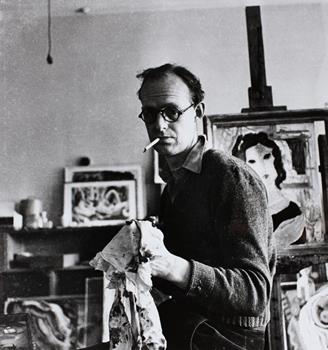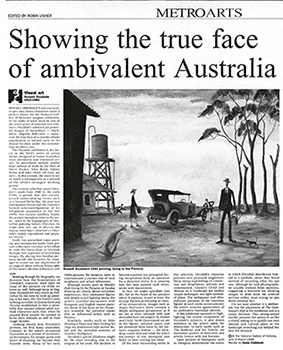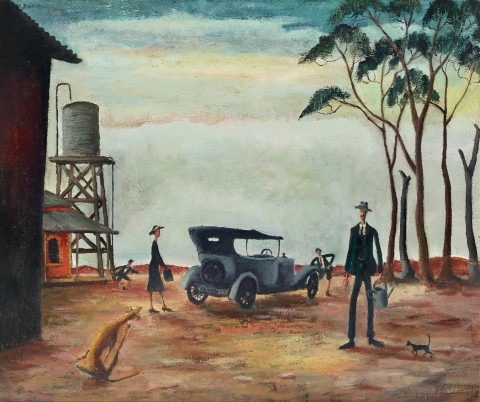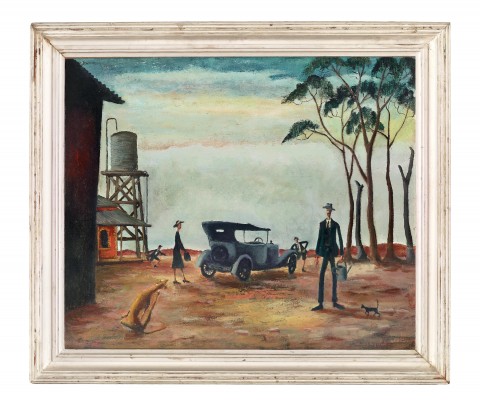GOING TO THE PICTURES, 1941
RUSSELL DRYSDALE
oil on canvas
46.0 x 55.0 cm
signed lower right: Russell Drysdale
inscribed with title on stretcher verso: GOING TO THE PICTURES/ Russell Drysdale 1941
inscribed on stretcher verso: RUSSELL DRYSDALE, 44 RUE DAGUERRE, PARIS 1938
Macquarie Galleries or Society of Artists, Sydney
Clive Turnbull, Melbourne, acquired from either of the above c.1942
Private collection, Melbourne, a gift from the above in 1962
Exhibition of Paintings by Russell Drysdale, Macquarie Galleries, Sydney, 11 – 30 March 1942, cat. 8 (label attached verso)
Society of Artists Annual Exhibition 1942, Education Department’s Art Gallery, Sydney, 2 – 24 September 1942, cat. 102
Russell Drysdale Retrospective 1937-1960, Art Gallery of New South Wales, Sydney, 5 October – 6 November 1960, cat. 21 (label fragment attached verso)
Russell Drysdale: A Retrospective Exhibition, Queensland Art Gallery, Brisbane, 22 April – 3 June 1961, cat. 14
Russell Drysdale. 3rd Adelaide Festival of Arts, John Martin’s Auditorium, Adelaide, 4 – 21 March 1964, cat. 58
Russell Drysdale: Paintings 1940 – 72, S.H. Ervin Gallery, Sydney, 14 June – 21 July 1985, cat. 6
Russell Drysdale, Monash University Gallery, Melbourne, 13 March – 16 April 1987, cat. 17
Russell Drysdale: 1912 – 81: National Gallery of Victoria, Melbourne, 19 December 1997 – 9 March 1998; Art Gallery of New South Wales, Sydney, 27 March – 10 May 1998; Queensland Art Gallery, Brisbane, 18 May – 28 June 1998; Museum & Art Gallery of the Northern Territory, Darwin, 20 July – 30 August 1998; Tasmanian Museum and Art Gallery, Hobart, 23 September – 15 November 1998, cat. 7 (label attached verso)
On loan to the National Gallery of Victoria, Melbourne 2009 – 2016
Dreamer, D., ‘Art – and some pictures that mystify’ Truth, Sydney, 6 September 1942, p.26
Society of Artists Book 1942, Ure Smith, Sydney, 1942, pp. 38 (illus.), 68
‘Russell Drysdale interprets Australia’, Australia National Journal, Sydney, 1 April 1942, p. 41 (illus.)
Society of Artists Book 1942, Ure Smith, Sydney, 1942, p. 38 (illus.)
Duhig, V. J., ‘Drysdale in Queensland’, The Bulletin, Sydney, John Haynes and J.F. Archibald, 3 May 1961, p. 40
Dutton, G., Russell Drysdale, Thames and Hudson, London, 1964, pl. 13 (illus.)
Haese, R., Rebels and Precursors: The Revolutionary Years of Australian Art, Allen Lane, Melbourne, 1981, pp. 260, 262
Klepac, L., Russell Drysdale, Bay Books, Sydney, 1983, pl. 36, p. 223 (illus.)
Sturgeon, G., The Painter’s Vision, Bay Books, Sydney, 1987, pp. 179, 182 (illus.)
Wilson, G., The Artists of Hill End, Beagle Press and Art Gallery of New South Wales, Sydney, 1995, p. 20 (illus.)
Smith, G., Russell Drysdale: 1912 – 81: National Gallery of Victoria, Melbourne, 1997, pp. 46-47 (illus.)
Klepac, L., Russell Drysdale The Drawings, The Beagle Press, Sydney, 2012, pp. 158, 159 (illus.)
Study for Going to the Pictures, 1941, pen and ink and pastel on paper, 23.0 x 29.5 cm, private collection, illus. in Klepac, L., Russell Drysdale the drawings, The Beagle Press, Sydney, 2012, p. 55 and cover
dh200292_RUSSELL DRYSDALE IN HIS STUDIO, 1939.jpg

Bernard Smith once described Russell Drysdale as ‘a twentieth-century [Henry] Lawson of painting.’1 Identifying the poet’s ‘compulsion to tell the truth as he sees it, his sense of the absurd, his humour, his craftsmanly respect for form, his humanity and … sentiment’2 in the painter, he established a literary precedent for Drysdale’s imagery. When his now iconic depictions of country Australia first appeared in the early 1940s however, there was no artistic precedent for the imagery of a harsh and unyielding landscape populated by stoic, resilient people. Representing a decisive break from the romantic pastoral imagery of the late nineteenth and early twentieth centuries, Drysdale’s vision focussed on the rural experience, infusing elements of Surrealism and Expressionism into his realistic approach, and – like Lawson’s verse – making a profound contribution to the development of Australia’s national identity.
The path that led Drysdale to a career as an artist was more coincidence than the result of careful planning. Recovering from eye surgery in 1932, he passed the time by drawing. Impressed by what he saw, Drysdale’s doctor, Julian Smith – ‘that strange and brilliant mixture of surgeon, artist and photographer’3 – showed his work to Daryl Lindsay. A successful painter, member of the famed artistic dynasty, and later director of the National Gallery of Victoria, Lindsay recalled that Drysdale’s work ‘showed a curious sensitivity and a sharp observation’4. Born into a family with extensive farming interests – including Boxwood Park in the Riverina district – the young Drysdale ‘liked Lindsay because he had had the same sort of life that I had led … He had been a jackeroo (sic) and a station manager and we could talk about horses and sheep.’5 Although Drysdale had always imagined a life on the land, this attention from respected artworld figures prompted him to consider a creative career and a subsequent introduction to George Bell, the influential modern artist and teacher, sealed his fate.
Drysdale enrolled at the Shore–Bell School in Melbourne in 1935 after extended travel in England and Europe. Having seen the work of the Impressionists and modern artists there for the first time, he was fuelled with the desire to paint, later saying, ‘I … got to like these things tremendously and I wanted to do it … quite suddenly they had a meaning which they never had in books.’6 He absorbed Bell’s teaching, which emphasised the importance of imagination and encouraged individual expression, as well as developing a sound technical knowledge of the materials and processes of his craft. Bell also instilled in his students the importance of drawing, believing that its practice ‘is as essential to an artist as practising scales to a pianist.’7
Drysdale’s first solo exhibition was held at Riddell Galleries, Melbourne in 1938. Including The Rabbiter and his Family, 1938 (National Gallery of Australia) and Monday Morning, 1938 (Metropolitan Museum of Art, New York), the critical response was overwhelmingly positive. Honing in on the authenticity and humanity of Drysdale’s depictions – borne in part from his firsthand experience of rural Australia and respect for those who lived and worked there – Basil Burdett wrote, ‘what really impresses one is that there is nothing merely cerebral in all this. There is a genial quality about these pictures which the purely intellectual experimenter never achieves’8. The Sun News-Pictorial reported that ‘Mr Drysdale is a young man who is about to leave for abroad to complete his studies in London and Paris, and, judging by this show no student has ever left Australia with such promise of a brilliant future before him.’9
Impending World War cut Drysdale’s time overseas short and he returned to Australia with his wife and young daughter in April 1939, managing a sheep property in Albury before settling in Sydney the following year.10 Frustrated by his rejection from the army due to ‘defective eyesight’, Drysdale channelled his energies into painting. Drawing on his recent experience of the country, memories of childhood and deep connection to rural life, he produced a series of images that represented a major breakthrough in his career. His creative momentum was buoyed in 1941 when, in the first institutional recognition of his talent, Monday Morning was acquired by the Metropolitan Museum of Art in New York. Included in The Art of Australia 1788-1941, an exhibition which toured the United States and Canada, the painting had been borrowed from the collection of Maie Casey – a friend and fellow Bell student, and wife of Richard Casey, who at that time was Australia’s first ambassador to the United States. She agreed to sell it knowing that being part of such an important international collection would be more beneficial to Drysdale than having the painting hanging on her wall.11 Similar acknowledgement of Drysdale’s work at home would follow soon after.
Towards the end of 1941 plans were made for a solo exhibition scheduled to take place at Sydney’s Macquarie Galleries in March the following year. Including nine drawings and thirteen paintings, the exhibition was opened by Sydney Ure Smith, the influential publisher of Art in Australia and keen supporter of young artists. Sunday Evening, 1941 was purchased by the Art Gallery of New South Wales, the largest and – priced at 45 guineas – most expensive work in the exhibition. Moody’s Pub, 1941, was acquired by the National Gallery of Victoria. Both paintings are now regarded as key works in the history of modern Australian art. The Sydney Morning Herald reviewer hailed Drysdale as a ‘young painter who possesses exceptional talents’, noting that he was ‘preoccupied … with instilling a definite Australian character – country rather than city – into his work.’12 As a mark of the significance of the works in this landmark exhibition, others including Man Feeding his Dogs, 1941 (Queensland Art Gallery/Gallery of Modern Art), Man Reading a Paper, 1941 (University of Sydney), and The Crow Trap, 1941 (Newcastle Region Art Gallery), have continued to be acquired for important public collections.
1111111111.jpg

Showing the true face of ambivalent Australia’,
The Age, Melbourne, 31 December, 1997, p. C7
Going to the Pictures, 1941 was purchased soon after the exhibition by Clive Turnbull, journalist, author, poet and critic. A highly respected writer, he worked on the Argus newspaper before joining the Melbourne Herald in 1932. Appointed to the role of art critic in 1942, his keen interest and knowledge about contemporary art was such that the newspaper’s chief, Sir Keith Murdoch, consulted Turnbull regarding his own art purchases.13 Turnbull’s selection of this painting suggests a fine sense of humour as well as a very good eye. Despite the rigours of life in such a setting, where dusty earth and a vast bleached sky dominate the view, the family is dressed for their outing in their Sunday best. Spindly trees echo the exaggerated form of the father’s limbs, while the dog in the foreground, contorting to scratch its neck, mirrors the awkward angularity of the playing boys. Water is clearly scarce, and Drysdale’s focus on the galvanised iron tank raised on its timber stand and the watering can – which has presumably just been used to fill the car’s radiator – emphasises its importance. While there is humour here, and Drysdale’s characteristically expressive handling of paint, there is also great empathy. Reflecting aspects of both what Drysdale saw and what he felt 14, these images are also what Geoffrey Dutton insightfully deemed ‘spiritual records’ of Australia.15
Russell Drysdale was not a prolific artist – in a career that spanned more than forty years he produced fewer than five hundred paintings. Going to the Pictures has remained in the Turnbull family since the early 1940s, but as a major example of Drysdale’s painting, it has been included in every major exhibition dedicated to his oeuvre since that time – most notably the retrospectives mounted at the Art Gallery of New South Wales in 1960 and at the National Gallery of Victoria in 1997 – and represents one of the most important examples of modern Australian art to appear at auction in many years.
1. Smith, B., Australian Painting 1788-1970, Oxford University Press, Melbourne, second edition, 1971, p. 247
2. Ibid.
3. Klepac, L., Russell Drysdale, Murdoch Books, Millers Point, 2009, p. 15
4. Ibid.
5. Drysdale interviewed by Geoffrey Dutton, quoted in Mary Eagle and Jan Minchin, The George Bell School: Students, Friends, Influences, Deutscher Art Publications, Melbourne, and Resolution Press, Sydney, 1981, p. 91
6. Klepac, op. cit., p. 21
7. Drysdale quoted in JF Nagle, ‘Preface’, Russell Drysdale, Richmond Hill Press, Melbourne, 1979
8. Klepac, op. cit., pp. 53-54
9. Ibid., p. 53
10. See Klepac, ibid., pp. 66-69
11. Ibid., p. 78
12. ‘Promising Young Painter’, Sydney Morning Herald, 11 March 1942, p. 7
13. Ryan, P., ‘Turnbull, Stanley Clive (1906-1975)’, Australian Dictionary of Biography, National Centre of Biography, Australian National University, http://adb.anu.edu.au/biography/turnbull-stanley-clive-11893/text21301, published first in hardcopy 2002, accessed 28 August 2020
14. Dutton, G., The Innovators, Macmillan, South Melbourne, 1986, p. 87
15. Klepac, op. cit., p. 42
KIRSTY GRANT

